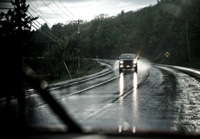States Implementing Wipers-on, Headlamps-on Law See Reduction in Fatal Crashes According to LRC Study
 In the past few decades, many states in the U.S. have enacted "wipers-on, headlamps-on" laws requiring the use of vehicle headlamps while driving during the daytime in weather conditions that require the use of windshield wipers. The logic for doing so seems simple enough—vehicles with their headlamps (and tail lamps) on will be more conspicuous to other drivers. But legislators in some states have resisted passing such laws because, until now, there was no direct evidence suggesting these laws have any meaningful benefits.
In the past few decades, many states in the U.S. have enacted "wipers-on, headlamps-on" laws requiring the use of vehicle headlamps while driving during the daytime in weather conditions that require the use of windshield wipers. The logic for doing so seems simple enough—vehicles with their headlamps (and tail lamps) on will be more conspicuous to other drivers. But legislators in some states have resisted passing such laws because, until now, there was no direct evidence suggesting these laws have any meaningful benefits.
The Lighting Research Center (LRC) at Rensselaer Polytechnic Institute recently found that the odds of being killed in a multiple-vehicle crash during daytime rain were about 8 percent lower after states enacted wipers-on laws, according to research recently published in the journal Safety Science.
LRC Senior Research Scientist and principal investigator John Bullough examined data from the National Highway Traffic Safety Administration (NHTSA) on fatal crashes during daytime and nighttime and during clear and rainy weather. He evaluated fatal crashes from several states that enacted wipers-on, headlamps-on laws and found statistically significant reductions in the proportion of daytime crashes in rainy weather after legislation was enacted, relative to the period before enactment. He notes that the relationship was found only for multiple-vehicle and not for single-vehicle crashes.
"Headlamp use during the daytime, even in the rain, doesn't add much to the total amount of light on the road, but it would make one's car more visible to others, so the effect should only be seen when more than one vehicle is involved in a crash," explained Bullough, who coordinates the LRC's transportation and safety research.
In an earlier paper presented in September 2011 at the International Symposium on Automotive Lighting (ISAL 2011) in Germany, Bullough compared rainy-weather crash data for dawn and dusk periods to those during the rest of the day. He found the reduction in multiple-vehicle crashes in rain during dawn and dusk after the enactment of wipers-on laws was four times larger than during the brighter part of the day, which is consistent with an earlier published study from Japan that showed that cars with their headlamps on were four times more noticeable during dawn and dusk than during the rest of the daytime.
"Finding statistical associations between lighting and crashes is important, but crash statistics alone can't prove cause and effect. For example, we don't know how many drivers in these states actually used their headlamps in the rain. But the agreement between the crash data and the noticeability data gives us more confidence in relating the visual benefits of lighting to safety," said Bullough.
Publications
Bullough, J. D. 2011. Efficacy of wipers-on, headlamps-on legislation.Safety Science 50:3; 575-578.
Sponsors
Transportation Lighting Alliance


